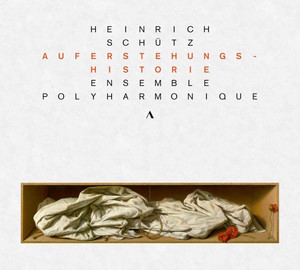
Heinrich Schütz (1585-1672)
Auferstehungshistorie (SWV 50)
Surrexit pastor bonus (SWV 469)
Franz Tunder (1614-1667)
Da pacem Domine:
Sinfonia à 7 viole
Heinrich Schütz
Historia der fröhlichen und siegreichen Auferstehung unsers einigen Erlösers und Seligmachers Jesu Christi (Auferstehungshistorie) (SWV 50)
Michael Praetorius (1571-1621)
Halleluja – Christ ist erstanden
Ensemble Polyharmonique/Alexander Schneider
Texts included, no translations
rec. 2022, Christuskirche Berlin – Oberschöneweide
Reviewed as a stereo 16/44 download with pdf booklet from Naxos
Accentus Music ACC30620 [63]
When Schütz was appointed Kapellmeister at the court in Dresden in 1617, it was tradition to perform every year the gospel of Easter on a setting by Antonio Scandello (1517-1580), one of Schütz’ predecessors in Dresden. It was only in 1623 that Schütz composed his own setting, the Auferstehungshistorie, as a replacement of Scandello’s setting which Schütz himself had performed in his first years in Dresden. It was his first contribution to the genre of the Historia. It linked up with tradition, but also contained some meaningful innovations.
Schütz uses the same text as Scandello, a compilation of the events of Easter from the four gospels, the so-called Evangelien-Harmonie (Harmony of the Gospels), by the Wittenberg reformer Johannes Bugenhagen (1485 – 1558). He also keeps the traditional recitation model, the Easter tone, for the part of the Evangelist. Scandello had set the parts of the individual characters – Jesus, Mary Magdalene and Cleopas – for up to four voices, in Schütz’s Historia they are set for two, with the exception of the part of Cleopas, which is given to a soloist. However, Schütz gave performers the option of assigning the second part to an instrument or omitting it altogether. The present recording follows the original intentions of the composer.
This is not the only innovation: the basso continuo was introduced to support the singers. And the objectivity of the traditional Historia was eliminated in favour of a more emotional delivery of the events at Easter. Schütz made use of Affekte and madrigalisms to translate the actions into music and to express the emotions of the characters in the story. Not only the part of the Evangelist reflects this approach, but also the accompaniment of this part, for which Schütz strongly preferred a consort of four viole da gamba. This way he creates a contrast between the Evangelist and the other parts, which is underlined by another of his suggestions regarding the performance: he preferred his Historia to be performed with two choirs, one of them the Evangelist with the consort of viols, the other the ‘choir of people’. He also wished only the Evangelist to be seen by the audience, whereas the other participants should be out of sight.
The work opens with an Introductio, the heading of the piece: “The Resurrection of our Lord Jesus Christ as it is described to us by the four Evangelists”. It is scored for six voices, and Schütz leaves it to the performers to add instruments, if they wish (“voces et instrumenta si placet”). Another episode for six voices is the exclamation of Jesus’ disciples, when the two men of Emmaus have told how they have met Jesus: “The Lord is risen and hath appeared to Simon!”, again scored for six voices. The closing chorus is for the full ensemble of eight voices: “Thanks be to God, who has given us the victory through Jesus Christ, our Lord!” The Evangelist adds his voice with the exclamation “Victoria!”, which is repeated a number of times. At the end he is joined by the ensemble.
The Auferstehungshistorie is one of the masterpieces of the 17th century, and stylistically it was ground-breaking. It set the tone for a development of the oratorio in Germany, which in the 18th century would result in the great oratorios by Bach. In the course of time I have heard a number of recordings of this work. Most of them I enjoyed, and this new recording is another one which I would like to welcome. Since its foundation, the Ensemble Polyharmonique has developed into one of the major forces with regard to the interpretation of 17th-century sacred repertoire. In this recording it shows once again its sensitivity towards the oeuvre of Schütz and his contemporaries. Among its strength is the excellence of its singers, individually and as an ensemble. All voices harmonize perfectly, and each singer is well aware of the importance of the text. Diction and pronunciation are immaculate.
One of the things I noted is the relative quiet tempo. This seems to be inspired by the consideration that Jesus’s pupils for a long time couldn’t believe that he was really risen. This is translated into a rather restrained performance of most parts of this work. This way the contrast with the two exclamations mentioned above is emphasized. From that angle the choice of tempo makes much sense. Personally I would have preferred a slightly faster tempo, but that is also a matter of taste. At three moments the performers inserted the sinfonia from the sacred concerto O bone Jesu (SWV 471). Although I have no problems with that, I don’t see the need.
Schütz’s Auferstehungshistorie is embraced by two other pieces. The disc opens with another concerto by Schütz, Surrexit pastor bonus, in the Roman Catholic liturgy a responsory for the second day of Easter, which refers to Christ’s passion: “The Good Shepherd is risen, who deemed it fitting to die for his flock”. The last piece is by Michael Praetorius, an older colleague of Schütz, whom he knew well. It is a typical Praetorius piece for eight voices in two choirs, with instruments ad libitum. It is a festive work, a fitting close of this fine disc that will give any lover of early music much to enjoy during the Easter period.
Johan van Veen
www.musica-dei-donum.org
twitter.com/johanvanveen
Help us financially by purchasing from





















